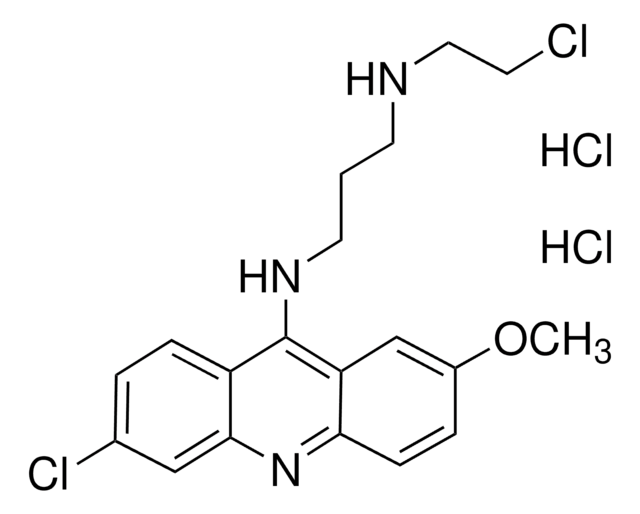The suitability of this compound for use in FACS has not been determined. This application would need to be validated by the end user. Please see the link below to a publication that may be helpful:
https://www.ncbi.nlm.nih.gov/pmc/articles/PMC6718257/
Q3251
Quinacrine dihydrochloride
≥90% (TLC), powder, MAO-A/B inhibitor
Synonym(s):
6-Chloro-9-(4-diethylamino-1-methylbutylamino)-2-methoxyacridine dihydrochloride, Atebrin dihydrochloride, Mepacrine dihydrochloride
Select a Size
About This Item
Recommended Products
Product Name
Quinacrine dihydrochloride, ≥90%
biological source
synthetic
Quality Level
assay
≥90%
form
powder
mp
257 °C
solubility
H2O: soluble, clear to hazy
originator
Bayer
SMILES string
Cl[H].Cl[H].CCN(CC)CCCC(C)Nc1c2ccc(Cl)cc2nc3ccc(OC)cc13
InChI
1S/C23H30ClN3O.2ClH/c1-5-27(6-2)13-7-8-16(3)25-23-19-11-9-17(24)14-22(19)26-21-12-10-18(28-4)15-20(21)23;;/h9-12,14-16H,5-8,13H2,1-4H3,(H,25,26);2*1H
InChI key
UDKVBVICMUEIKS-UHFFFAOYSA-N
Gene Information
human ... MAOA(4128) , MAOB(4129)
Looking for similar products? Visit Product Comparison Guide
General description
Application
Biochem/physiol Actions
Features and Benefits
Storage and Stability
Other Notes
signalword
Warning
hcodes
Hazard Classifications
Acute Tox. 4 Oral
Storage Class
11 - Combustible Solids
wgk_germany
WGK 3
ppe
dust mask type N95 (US), Eyeshields, Gloves
Choose from one of the most recent versions:
Already Own This Product?
Find documentation for the products that you have recently purchased in the Document Library.
Customers Also Viewed
-
Is it okay to measure fluorescence by using FACS? (with FITC Fluorochrome)
1 answer-
Helpful?
-
-
How long can it be used after purchasing?
1 answer-
This product is not assigned an expiration date or recommended retest date. Products with no expiration date or recommended retest date should be routinely inspected by customers to ensure they perform as expected. These products are also subject to a one-year warranty from the date of shipment. For more information, you may access the Product Dating Information document under ADDITIONAL USEFUL DOCUMENTS ABOUT OUR PRODUCTS at the bottom of the Quality Services page with this link: https://www.sigmaaldrich.com/US/en/life-science/quality-and-regulatory-management/quality-services.
Helpful?
-
-
I’m planning to make stocks for 10mM. What is the storage temperature? Is it same with the product?
1 answer-
Stock solutions are stable for up to 60 h at 20°C.
Helpful?
-
-
What is the storage temperature?
1 answer-
Product Q3251, Quinacrine dihydrochloride, is stored at room temperature.
Helpful?
-
-
What is the Department of Transportation shipping information for this product?
1 answer-
Transportation information can be found in Section 14 of the product's (M)SDS.To access the shipping information for this material, use the link on the product detail page for the product.
Helpful?
-
-
Can Product Q3251, Quinacrine dihydrochloride be used for staining platelets?
1 answer-
We have not tested Product Q3251, Quinacrine dihydrochloride for staining platelets. The reference link indicates that platelets can be visualized with the fluorescent dye mepacrine (quinacrine dihydrochloride) at a final concentration of 10 μM. Brian Savage, et al., PNAS, 99 (1): 425-430, (2002).
Helpful?
-
Active Filters
Our team of scientists has experience in all areas of research including Life Science, Material Science, Chemical Synthesis, Chromatography, Analytical and many others.
Contact Technical Service









